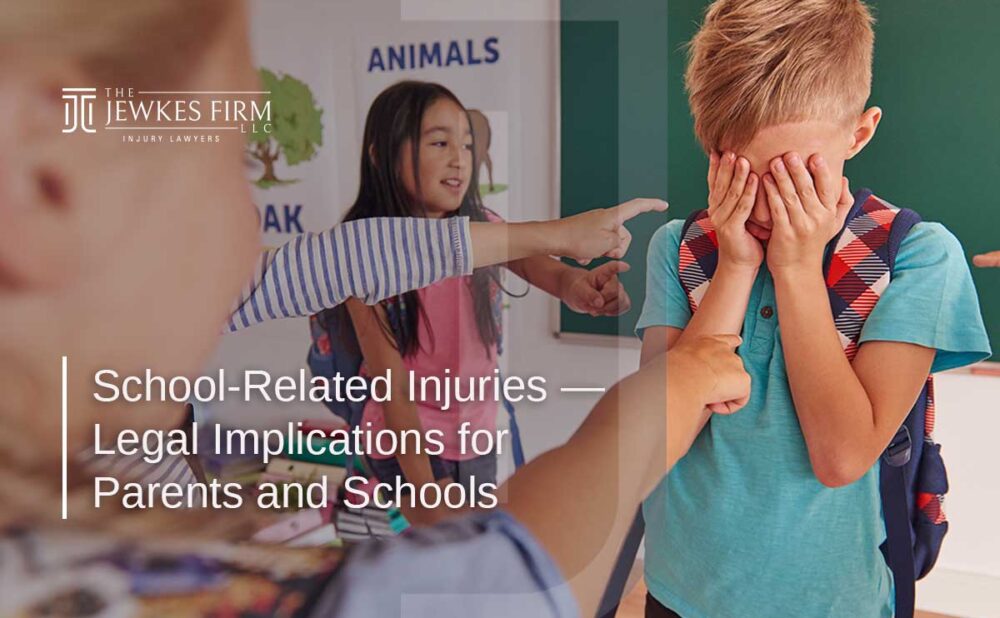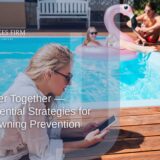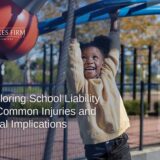Common School-Related Injuries in Georgia — Legal Implications for Parents and Schools
The onset of the back-to-school season in Georgia brings with it not only excitement but also significant safety concerns for children. During this time, the likelihood of accidents, including school bus incidents, pedestrian mishaps, and bicycle-related injuries, notably increases. In addition, children face risks from injuries on school grounds and during sports activities.
As parents, educators, and community members, we all want our children to have a safe and enriching school experience. However, accidents can and do happen, leading to injuries that may require legal attention. At The Jewkes Firm, we recognize that dealing with school-related injuries in Georgia can be complicated. We help families as they work through these tough situations. This article will look at common injuries that happen at school, their causes, and what you can do if your child gets hurt while at school.
Why School-Related Injuries Matter
School-related injuries can occur in various settings, including classrooms, playgrounds, sports fields, and during transportation to and from school. These injuries can range from minor scrapes and bruises to more severe conditions requiring medical attention. Understanding the common types of injuries can help parents and guardians recognize potential hazards and take preventive measures.
In Georgia, unintentional injuries are the leading cause of death for children ages 1–4, resulting in about 74,000 emergency visits annually and roughly 5,500 fatalities statewide in 2020. Schools, where children spend much of their day, can unfortunately account for a meaningful share of these incidents.
Injured in a Rideshare Accident? Contact Us For A Free Consultation
Injured in a Rideshare Accident?
Common Types of Injuries in Schools
Children are susceptible to a variety of injuries while at school, which can arise from diverse circumstances, including playtime mishaps and conflicts with peers. Here are several prevalent categories of school-related injuries:
Pedestrian and School Zone Accidents
Dozens of Georgia students are struck by motor vehicles each year, some fatally—even with crossing guards, reduced speed zones, and warning lights in place.
- National data show nearly 25% of high schoolers and 16% of middle schoolers get distracted while walking—by phones or headphones—raising risk in school zones.
Why this matters legally: Under Georgia premises liability and negligence standards (O.C.G.A. § 51‑3‑1), schools and local governments can be held responsible if unsafe zones or insufficient crossing aids lead to injuries.
School Bus and Transportation Injuries
Students can get hurt while being taken to and from school, whether by bus or car. Accidents can result from driver negligence, improper loading and unloading procedures, or lack of seatbelt use.
- Nationwide, injuries from school bus crashes have declined from ~24,000 in 2013 to ~12,500 in 2022.
- In Georgia, 27 fatal school-bus-related crashes occurred between 2018 and 2022, resulting in 29 deaths (5 were school-aged children—3 pedestrians, 1 occupant, etc.).
Schools should implement strict safety protocols for transportation and ensure that drivers are adequately trained. Liable parties may include school districts, bus drivers, or third-party contractors. Public entity cases must navigate Georgia’s specific notice requirements.
Playground Injuries
Falls from swings, slides, or climbing structures are among the most common playground injuries. Lack of supervision, poorly maintained equipment, or unsafe surfaces can contribute to these accidents.
- Nationally, over 200,000 children under 14 go to the emergency room for injuries they get on playgrounds. Schools account for ~46% of these incidents.
- Common injuries include fractures (≈39%), lacerations (22%), contusions (20%), sprains (11%), especially from falls (≈79%–81%).
Regular inspections of playground equipment and ensuring that adults supervise children during playtime can help reduce the risk of injury.
Sports Injuries
Injuries related to school sports can include sprains, fractures, concussions, and overuse injuries.
- Georgia reported nearly 28,000 concussions in 2016, resulting in over 7,000 hospital visits. Youth ages 10–19 comprised 21% of traumatic brain/spinal injuries.
- High school sports like football, basketball, and cheerleading pose elevated concussion risks.
Liability issues arise from inadequate coaching, poor equipment, or unsafe playing conditions. Schools should enforce safety protocols, provide proper training, and ensure that athletes wear appropriate safety gear.
Classroom Injuries
Classrooms and hallways can present their own set of dangers. Injuries in the classroom can occur due to slips, trips, and falls, as well as accidents involving classroom equipment. Common accidents include tripping over loose cords, falling on uneven flooring, or being struck by unsecured objects. Slips and falls caused by wet floors, uneven surfaces, or clutter are commonly seen in:
- Hallways
- Cafeterias
- Gymnasiums
Teachers and staff should maintain a clean and organized classroom environment and promptly address any hazards. Such cases hinge on whether the school knew—or should have known—about the hazard and failed to address it.
Bullying and Physical Assault
Physical altercations or bullying can lead to injuries that may not be immediately visible. Physical violence, bullying, or assault is an unfortunate school hazard, leading to both bodily harm and emotional trauma (PTSD, anxiety, depression). A lack of supervision or inadequate anti-bullying policies can contribute to these incidents. Georgia law requires schools to act against known bullying. Failure to intervene may constitute negligence.
Schools should foster a safe environment by implementing anti-bullying programs. Staff training is critical to manage conflicts effectively.
Food-Related Illness
Food poisoning or severe allergic reactions from cafeteria food are reportable school risks. Foodservice providers or the school could be held responsible if they ignore food safety rules.
Legal Framework for School-Related Injuries in Georgia
If your child gets hurt at school, it is essential to understand your legal rights and options. In Georgia, schools have a duty of care to provide a safe environment for students. If negligence on the part of the school or its employees contributed to your child’s injury, you may have grounds for a personal injury claim.
- Duty and Negligence. Schools owe a duty to students under premises liability law (O.C.G.A. § 51‑3‑1).
- Immunity Exception. Under GA Code § 51‑1‑30.3, public schools and volunteers enjoy immunity unless conduct was grossly negligent or willfully harmful.
- Notice Requirements. Claims against public schools require timely notice—often within 12 months for buses and property-related incidents.
- Statute of Limitations. Standard personal injury timeline is 2 years from injury discovery. For minors, tolling applies until age 18, so effectively until age 20.
Recent Changes to Georgia Law
- Tort Reform. In April 2025, Governor Kemp signed reforms limiting negligence claims, capping awards, and altering evidentiary rules—potentially increasing hurdles for injury claims.
- School Safety Bill. House Bill 268 (April 2025) now requires mental-health coordinators in each district, panic buttons for staff, and law-enforcement notifications for violent threats—helping prevent violent or assault-related injuries.
Protecting Students and Legal Options After an Injury
Parents and guardians should:
- Obtain immediate medical and incident documentation—photos, statements, medical records.
- Note any signs of inadequate supervision, unsafe equipment, or hazardous zones.
- Take quick action on public school claims and make sure to file the notice within one year.
- Engage a qualified child injury attorney early—especially given new tort reforms.
How The Jewkes Law Firm Can Help
- Experience in School Zone Cases involving pedestrian injury or negligent traffic controls.
- Bus Crash Specialists with knowledge of contractual and governmental immunity defenses.
- Playground & Sports Injury Claims, including concussion protocols and expert testimony.
- Bullying/Assault Incidents, holding schools accountable for negligence.
- Knowledgeable in food safety and slip-and-fall school premises cases.
- Well-versed in statutory timelines, public entity filings, and navigating Georgia Tort Reform for maximum recovery.
School-related injuries in Georgia are tragically common—but often preventable. Whether it’s a playground fracture, concussion, bus collision, or bullying incident, families deserve accountability and justice. With evolving legislation and legal barriers, early action is vital. If your child has suffered a school-related injury, don’t wait. Reach out to The Jewkes Firm today at (770) 771-5130 for a free evaluation.

GEORGIA PERSONAL INJURY LAWYER NEAR ME
Frequently Asked Questions
Can I sue a Georgia public school for my child’s injury?
Yes, but with restrictions. Public schools have certain immunities. If the school’s negligence directly caused your child’s injury, you may be able to file a claim. Public schools may have immunity under the Georgia Tort Claims Act, but there are exceptions.
What should I do if my child get hurt at school in Georgia?
First, seek medical attention for your child. Then, document the incident, notify school officials, and consult a personal injury attorney to understand your rights and options.
Who can be held liable for a school-related injury?
Depending on the situation, liable parties may include the school district, staff, a bus company, or even third-party contractors or negligent students (in bullying cases).
How long do I have to file a school injury claim in Georgia?
Georgia's statute of limitations is typically two years from the date of the injury. However, if the injured party is a minor, the time may be extended until they reach the age of 18.
What is school liability?
School liability refers to the legal responsibility that schools have to ensure the safety and well-being of their students. If a school fails to provide a safe environment, it may be held liable for any injuries that occur.




